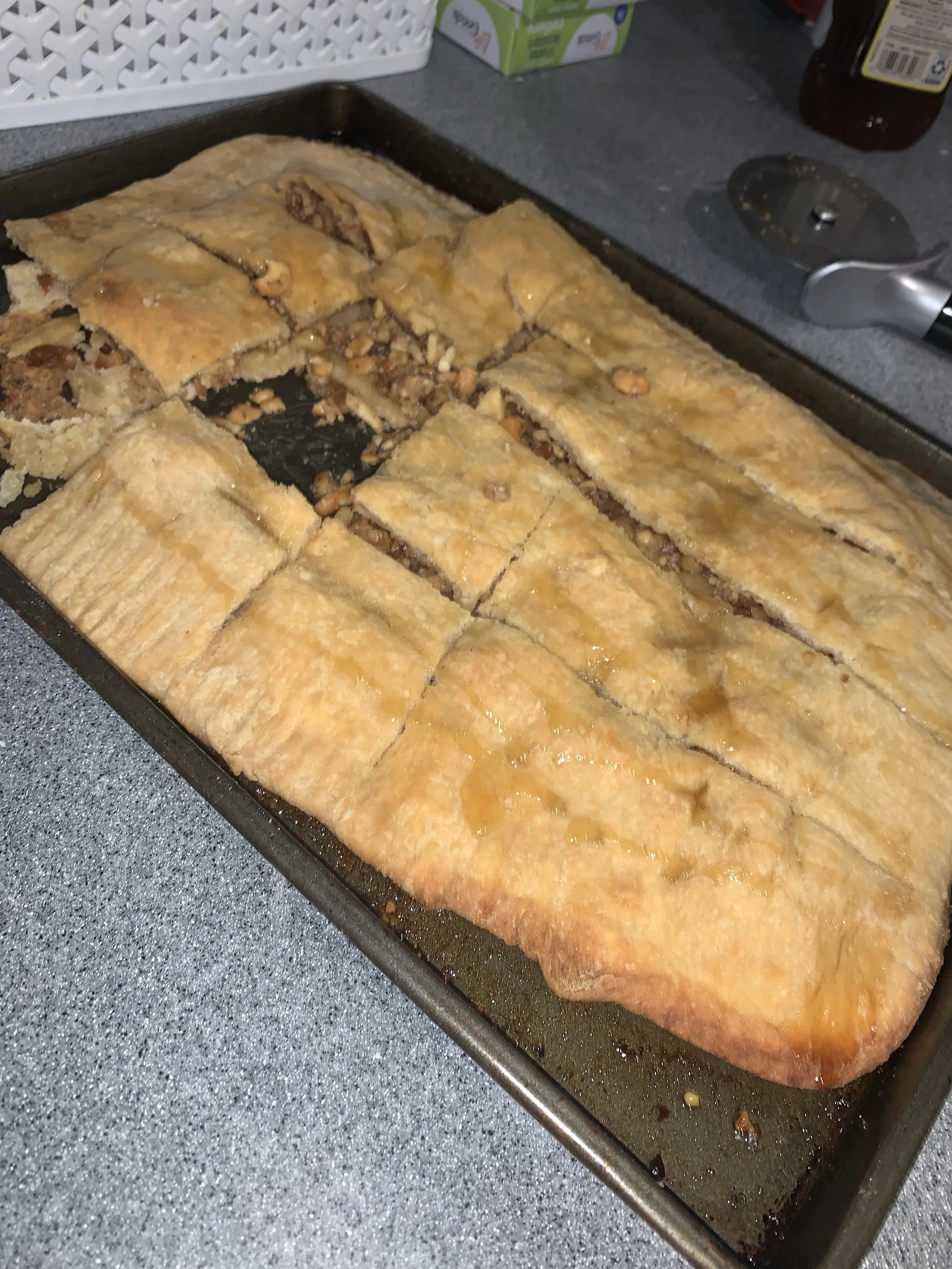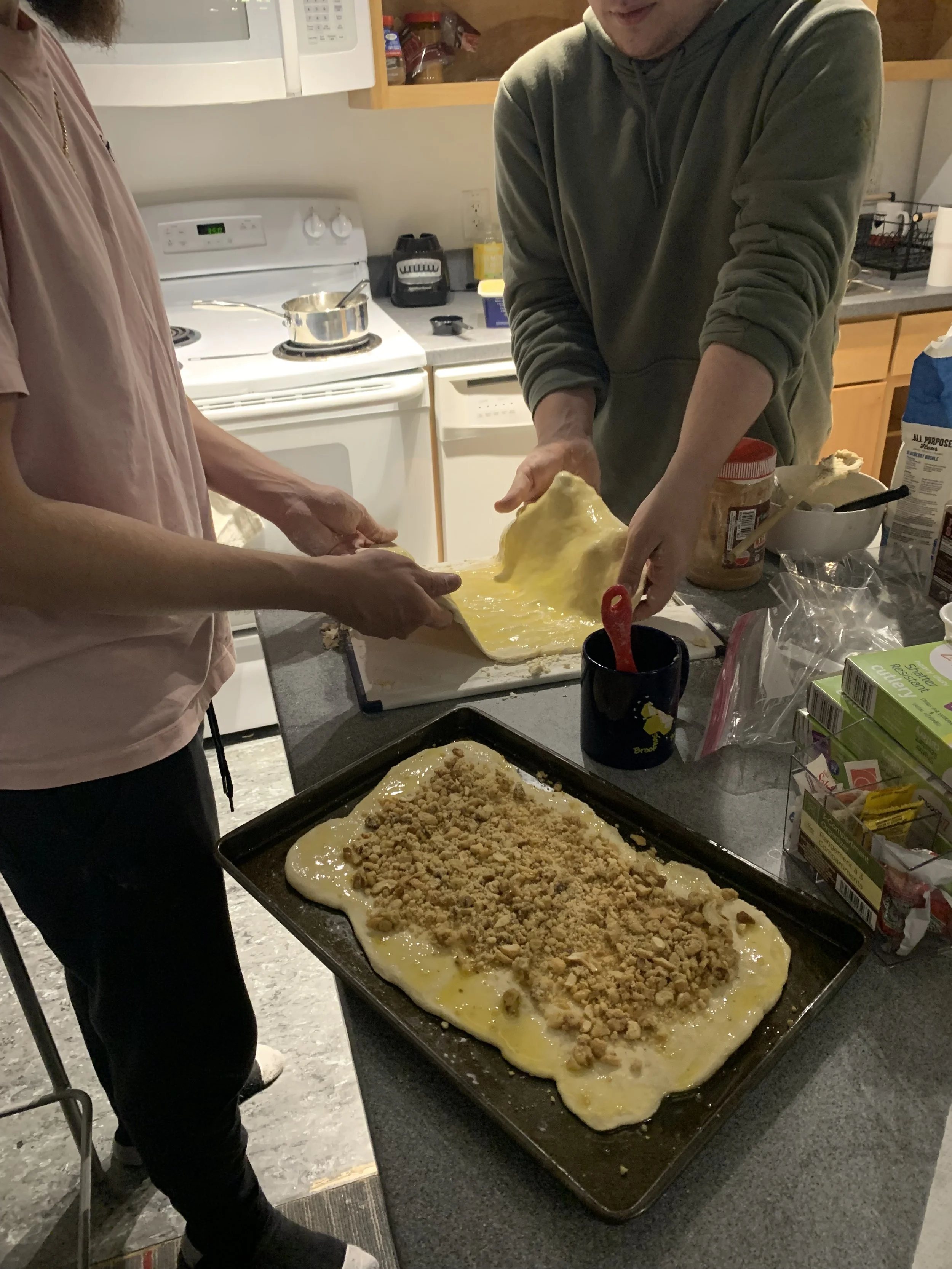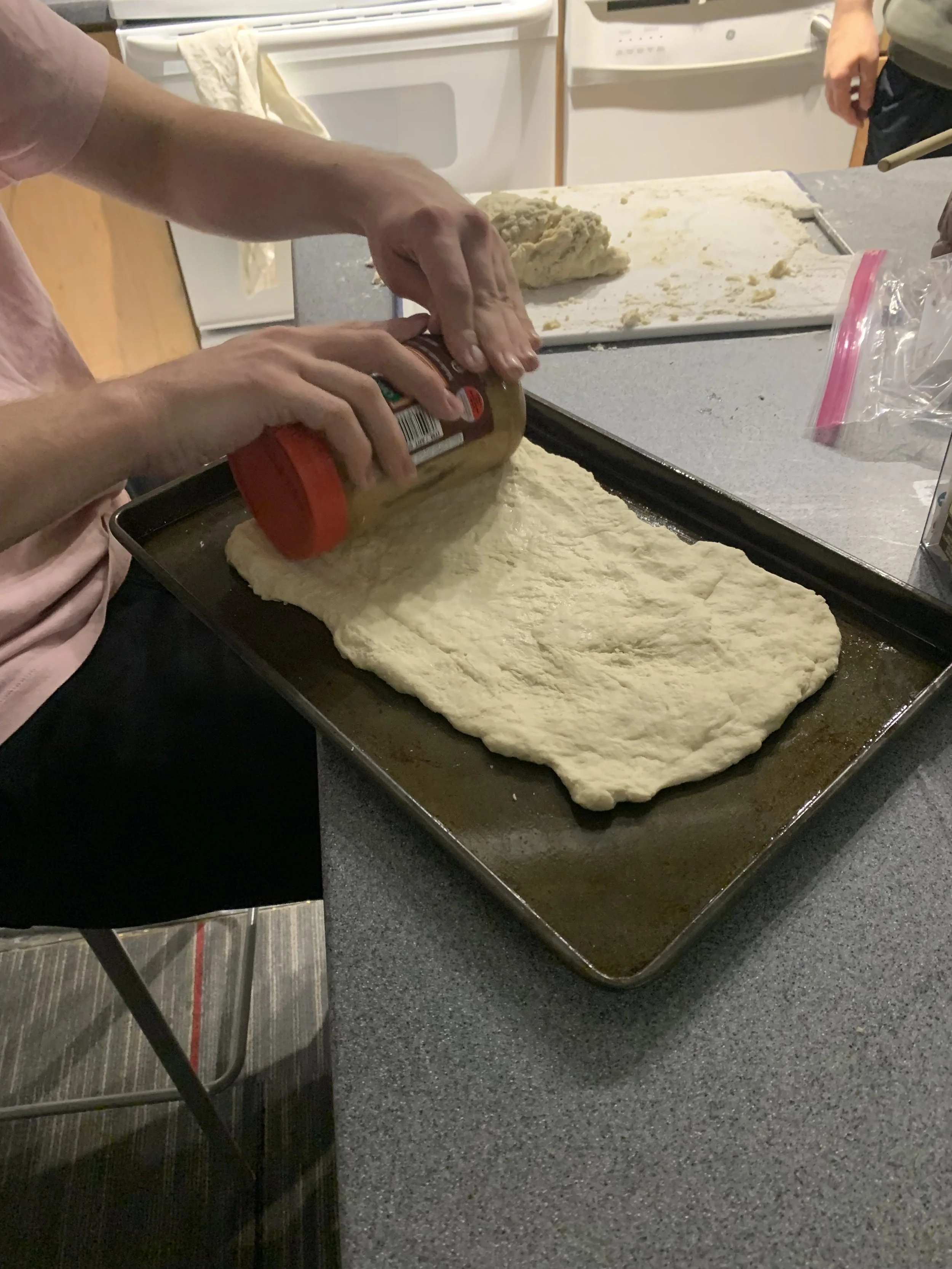Cheese Baklava: Gastronomical Re-innovation in Premodern China
Introduction
There is nothing quite like the sweet tingling sensation of biting down on a soft, crispy, delicate piece of baklava. The taste of the honey glaze harmoniously oozed over the finely chopped nuts tucked gently away under puffy filo pastry is nothing but magical. While nowadays one might be able to find this dish in a restaurant or at a family gathering, baklava originated from Türkiye while still part of the Ottoman Empire, and is a staple for many eastern Mediterranean countries including Greece and Syria. Interestingly, baklava’s reach extended far past the Middle East making its way into China. Even more interesting is that one variation of this baklava during the Ming Dynasty contained cheese, a food that is no longer seen as a part of traditional Chinese cuisine. By physically making the baklava as well as studying its origins, the Chinese can be seen as culinary re-innovators as they adapted a dish provided via global trade to their own localized needs rather than just imitating a beloved Ottoman delicacy.
Origins of Baklava
Baklava, as a craft, has a global history that extends as far back as the eighth century B.C. in the Assyrian Empire, when it was eaten for special occasions. Similarly to baklava, the Assyrians placed nuts between layers of thin bread. Developed independently in Ancient Greece and Rome, placenta cake, which many see as a precursor to baklava, was developed. Unlike modern-day baklava, placenta cake had cheese, honey, and bay leaves between layers of dough. Earlier Greek versions of the cake included walnuts as well. The most common variation of baklava that we are most likely to eat today was initially created and developed during the Ottoman Empire in the 15th century to eat during celebrations such as Ramadan. Baklava became a sacred part of Ramadan as the Sultan would gift the treat to elite soldiers during the Baklava Procession. This was because of the high price of nuts, sugar, and honey, as well as its difficulty to make. Later, baklava would spread to other holy holidays for Christians and Jews. Baklava’s popularity surged as a result of this multi-cultural importance spreading throughout the Middle East and the Mediterranean via trade routes and pilgrimages during the 16th Century. As it spread, each culture would create its own slight variations on the treat including different types of nuts, spices, amount of sugar, how and what shape it was served in, and even how many layers of dough ranging from 8 to 50 layers. [1]
Figures 2-4: Placenta Cake [5]; Turkish Gullach [6]; Cut Cake [7]
Cheese & Baklava in China
However, baklava’s reach went even further into China. The wealthy in China had in fact already been developing a liking for Muslim delicacies since the 13th century obtained via trade routes such as the Indian Ocean route by Muslim merchants and bureaucrats and pilgrimages. In China, there have been recipes for baklava dating back to the 14th century; one of which is for Turkish gullach, an ancestor of baklava containing layers of bean paste pancakes with nuts, honey, and milk. Today, the only thriving variant of baklava in China can be found in the Xinjiang Province in Central Asia. This Uygur snack, qiegao (切糕) or cut cake, contains corn syrup, candied fruits, nuts, and flour. Despite this, evidence from a cookbook in Shanghai suggests that baklava at one point had spread across the entire Asian continent, and even was developed to contain cheese similar to its ancestor placenta cake. [2]
Despite contemporary thought among the populace and current rates of lactose intolerance, cheese consumption was quite common in premodern China. Cheese first started to become popular during the 6th century AD when they figured out how to make raw cow’s milk edible for the population. While many scholars believe that dairy left China around the same time the Mongols did in the 14th Century, recipes from Southern China collected in Mr. Song’s Book of Nourishing Life demonstrate otherwise. The most common way to make “cheese” in Mr. Song’s cookbook was in the form of “milk cakes” or rubing (乳饼). Milk cakes were made by:
Gather cow’s milk and pour it into a pot, cooking it until hot, then take the souring agent and drip it into the milk little by little. Once [the curds] form, collect them with a cotton wrap to form a cake. [3]
The “souring agent” in the recipe usually refers to an acidic substance such as vinegar or lemon juice. As this acid mixes with the milk, the cheese begins to form into chunks, and once removed from heat, they form together with cheesecloth into a “milk cake”.
Figure 5: Milk Cakes in Market [3]
These “milk cakes” were the first step in the process of making the Chinese variant of baklava. While there are multiple recipes from China for baklava, in Mr Song’s Book of Nourishing Life:
One recipe uses fresh milk cakes. Knead them into the flour, and combine them with salt and a mix of cold and boiling water. Roll out the dough into a thin cake. Then bake in an oiled pan, brushing [the pastry] with honey or sugar and sprinkling in peeled and minced walnuts, hazelnuts, and pine nuts. Roll to [serve] to eat. It is also suitable to knead shortening into the dough. [3]
Unlike placenta cake, the baklava's cheese is kneaded into the flour rather than being a visible element. The dough is also rolled rather than stacked to create layers. One scholar's attempt at recreating the recipe demonstrates this difference.
Scholar’s Trials
University of Michigan Professor of Chinese Studies, Miranda Brown, replicated Mr. Song’s baklava recipe for her blog, Chinese Food History. One observation she had is that while the cheese was not visible or even detectable by taste in the dish, the cheese did make the dough richer. Similarly to traditional non-Chinese baklava, the dough was rolled to be very thin and semitransparent. The cheese acted as a strengthener to make the dough sturdier allowing the baklava to hold together. Brown’s replication of Mr. Song’s baklava can be seen in Figure 6. [4] The biggest observation that can be seen from Brown’s replication is that it looks nothing like baklava. While baklava from the Mediterranean and the Middle East tends to be denser and is usually cut into a quadrilateral shape, this recipe of baklava from Southern China is rolled up and appears to be lighter demonstrating that the Chinese were not intimidating a dish they learned from Muslims traders. Additionally, the rolled-up baklava appears similar to other breaded snacks such as youtiao (油条), which is also from Southern China, and Chinese pancakes. This demonstrates that the Chinese may have adapted the Muslim recipe to fit their own local tastes, but they most likely did not imitate it. On top of that, the use of cheese for not the purpose of taste but rather structure illustrates gastronomical innovation as they were experimentally changing up the molecular makeup of the dough rather than just pouring it on the dish. While cheese has been used in the past for baklava variants and ancestors such as placenta cake and gullach, the cheese was used for structural rather than taste purposes again disproving imitative behavior. The Chinese use of cheese in baklava was also developed independently of the Greeks and the Turks, thereby showing that the Chinese re-innovated baklava. Overall, this Southern Chinese recipe of baklava illustrates that while they did not invent baklava, the Chinese were able to innovate and adapt it to fit their own local needs.
Figure 6: Brown’s Baklava [4]
Own Experimentation
Because of the Chinese’s re-innovation of baklava, our own experiment in trying to recreate Mr. Song’s recipe proved difficult. Instead of being rolled up like it was supposed to be, we decided to make the baklava into a square using multiple layers of dough similar to baklava more commonly seen in the West. Due to the multiple layers of dough, the final product ended up denser and closer to Middle Eastern rather than Mr. Song’s baklava. Besides not knowing what Chinese baklava was supposed to look like, the lack of specific measurements from Mr. Song also proved challenging. This included the amount of flour and ratio of dough and cheese needed for the recipe. For flour, the only way around that was to add enough flour until the dough was able to form, and from there we added all of the cheese we could make. In the future, we would take a different approach by intentionally making less dough to increase the cheese-to-dough ratio while also making it not as thick. From this process, I am curious about why these snacks were created to be thin and flaky rather than dense, as well as whether baklava was eaten as street food or eaten in a different setting in China.
Figures 7-10: Emre O. and I’s experimentation with making Mr. Song’s baklava [8]
Additionally, we were able to identify all the materials needed for the baklava as specified in the recipe including a pot, stove, cheesecloth, rolling pin, pan, and brush. However, we were not able to procure everything such as a cheesecloth. Instead, we used a strainer because the cheese did not need to be formed into a milk cake, but rather just folded into the dough. Therefore, it was reasonable to only need to collect the cheese curds from the boiling water. Also, because we did not know what the baklava was supposed to look like, we cooked it on a baking sheet rather than a pan to create a baklava we were more familiar with. We also did not have a rolling pin, so we used a peanut butter jar to roll out the dough which worked surprisingly well. When tools were inaccessible, we learned that the best way to replicate their intended effect was to remember what the purpose of the device was, and what we needed the device to do. Then we picked another device that best did what we needed to do. In the case of the rolling pin, we chose the peanut butter jar because it was also round and dense enough to shape the dough. In terms of ingredients, there were not many varieties of ingredients, so we just chose what was most accessible. Based on all of the changes we had to make to the technology of the recipe, we demonstrate that this recipe of Chinese baklava, while containing similar components, is very different from the traditional baklava from the Ottoman Empire illustrating that the Chinese truly had to re-innovate baklava as both the physical dish and the methodology are not at all similar to the original.
Conclusion
Overall, by looking at the long history of baklava dating back to the Ottoman Empire as well as its ancestors from Ancient Greece, we can see that the Chinese version of baklava obtained via trade has been re-innovated both due to its physical and molecular structure but as well as the different methodology needed to make it. This demonstrates that China was not a culture of imitation but could innovate a global product to fit their localized needs.
Works Cited
[1] Moretti, John. “The Sticky History of Baklava.” Smithsonian Magazine, 22 Aug. 2023,
www.smithsonianmag.com/travel/the-sticky-history-of-baklava-180982771/.
[2] Marchetti, Silvia. “How Halva, Baklava, and Turkish Delight Were Baked into Chinese Cuisine
Centuries ago, and the Mooncake’s Arabian Cousin.” South China Morning Post, 28 Oct. 2021, www.scmp.com/lifestyle/food-drink/article/3153860/how-halva-baklava-and-turkish-delight-were-baked-chinese.
[3] Brown, Miranda. “Mr. Song’s Cheeses: Southern China, 1368–1644.” Gastronomica, vol. 19, no.
2, 2019, pp. 29–42, https://doi.org/10.1525/gfc.2019.19.2.29.
[4] Brown, Miranda. “A Chinese Cheese “Baklava” (16th Century).” Chinese Food History, 7 Aug.
2019, www.chinesefoodhistory.org/post/a-sixteenth-century-cheese-baklava-shanghai.
[5] Miller, Max. Placenta Cake, www.tastinghistory.com/recipes/placenta.
[6] Turkish Style Cooking. Turkish Gullach, turkishstylecooking.com/gullac-recipe.html.
[7] Chien, Popo le. Qiegao, 2014, en.wikipedia.org/wiki/Cut_cake#/media/File:Qiegao2.JPG.
[8] Finer, Sam. Making Mr. Song’s Baklava, 2025.








